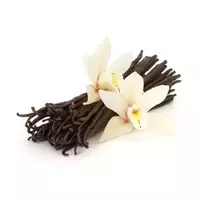Vanilla

The perennial liana, which belongs to the orchid family, is called vanilla. Mexico is considered the birthplace of this mysterious plant, and it is currently grown in the Caribbean, South America, Sri Lanka and Madagascar.
When wild-growing, vanilla clings its curly stems to the trunks and branches of neighboring trees, and the cultivated plant propagates with cuttings, attaching them to special supports or small trees. In the third year of life, vanilla begins to bear fruit. Interestingly, large greenish-white vanilla flowers, which open only for one day, pollinate artificially. As a result, a long and thin pod box is born in place of the fragrant flower, which is used by culinary workers around the world, thanks to the incredibly strong aromatic properties of vanilla. But before getting into the kitchen, this expensive spice goes through quite a long treatment.
Vanilla fruits are always harvested unripe, after which they are placed in hot water for a while so that the pod does not have time to open. At the next stage, the boxes are wrapped in woolen cloth for a week to ripen. After such procedures, vanilla pods acquire a brown color and a unique aroma. But this is not all: the fruits must be thoroughly dried. To do this, the spice is left to air in the fresh air (up to five months) until the fruits are covered with white plaque.
High-quality vanilla is easy enough to identify by its appearance: the pod should be elastic, soft, slightly twisted, oily to the touch, and its color is dark brown, with barely noticeable white crystals on the surface. In order for the saturated aroma and specific properties of vanilla not to evaporate, it should be stored in a special sealed package. So the aroma of this spice will continue for many years.
In cooking, vanilla is usually used in the form of pods and powder, which is obtained when grinding fruits. Currently, natural flavoring is increasingly being replaced by artificial vanillin, due to the high cost of natural spice. But it should be noted that the flavor of natural vanilla is many times stronger than vanillin, so true connoisseurs never use an industrial product.
The calorie content of vanilla is 287 kcal per hundred grams, but this is completely unimportant, due to the fact that only a minimum amount of spice is enough to prepare a dish. Since natural vanilla tastes bitter enough, it should be ground with powdered sugar (one pod per half a kilogram of sugar) before consumption. In addition, you can store whole fruits in one jar with sugar sand: vanilla will quickly impregnate sugar with its aroma and then it can be used to prepare confectionery products.
Most often, for culinary purposes, vanilla is used to make pies, puddings, creams or cookies. It's just perfect as a great flavoursome addition to dairy and curd dishes. In addition, this spice is well combined with milk and chocolate cocktails, as well as other drinks. Often vanilla is added to the dough, which as a result is used to make cakes.
In the confectionery industry, vanilla also plays an important role, often it is added to chocolate and candy as a natural aromatic additive. Interestingly, natural vanilla can be obtained not only from the pods of the plant - it is formed in oak barrels, in which elite cognac insists.
vanilla 287 kCal
Energy value of vanilla (Ratio of proteins, fats, carbohydrates - ju):
Proteins: 1.2 g (~ 5 kCal)
Fats: 0.1 g (~ 1 kCal)
Carbohydrates: 12.5g (~ 50kCal)
Energy ratio (bj | y): 2% | 0% | 17%
 Español
Español Français
Français Português
Português Русский
Русский 简体中文
简体中文 繁體中文
繁體中文 日本語
日本語 한국어
한국어 العربية
العربية Türkçe
Türkçe Қазақ
Қазақ Deutsch
Deutsch Italiano
Italiano Українська
Українська
